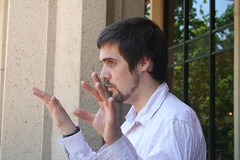some qualifiers on that: one of the reason that i plan on using my free ole miss classes (hooray for university employment) to study economics is so that i can fill in these broad strokes. however, it will nevertheless remain true that one of my go-to answers to the story circle question, "when was first time it became clear that race was the elephant in the room" will be: when i came back from my first year at amherst college-- a profoundly diverse place in many respects (race, class, region, nationality)-- and attended the graduation of my great, childhood friend, sean wilbur, at fairview park high school (fairview park was the suburb that i grew up in), i was struck with the sense that something was missing as i looked at the sea of white faces on the auditorium stage. it was, very simply, other people-- perhaps some in the sea of black/brown faces undoubtedly on an auditorium stage in the cleveland public school district around the same time. i guess it became at that point very viscerally odd that both seas laid claim to the cultural signifier "cleveland"-- but that same term meant such different, and at times contrasting things. now, this would all be fine and well if these terms were in a healthy sociolinguistic engagement (which is probably part of the democratizing possibility of a city-- and all the different, contrasting things it requires to be in the same place at the same time), but they weren't. the same, of course, with "jackson."
here's to being a progressive, snooty, pseudo-intellectual limousine liberal:
from, "A Suburb Looks Nervously At Its Urban Neighbor," in The New York Times, January 17, 2008:
Mr. McDermott was taking a walk early New Year’s Eve when a group of young African-Americans attacked him from behind. They slashed his face, kicked him, and mashed his leg with a lead pipe, the police said. A neighbor banging on a window scared the teenagers away.
[...]
Scott Lee, the acting police chief of Shaker Heights, said the beating was a random crime of opportunity and was not gang-related.
Ludlow is a neighborhood of tidy Tudor and colonial homes with small yards shaded by mature sycamore trees. Part of the neighborhood lies in the affluent suburb of Shaker Heights and the other part lies in Cleveland, the fourth-poorest city in the country, according to the Census Bureau. Children on both sides of the neighborhood attend Shaker Heights public schools. The only way to know which city you are in is to look for the street signs, which in Cleveland are blue and in Shaker Heights are white.
Mr. McDermott was attacked on a quiet street one block south of Ludlow Elementary School, which in the 1950s and ’60s became the center of Shaker Heights’s successful integration effort.
[...]
What has surprised Ludlow residents most since the attack is the reaction of people around the region.
[...]
“So move,” Dick Feagler, a columnist for The Cleveland Plain Dealer, wrote after the attack. “But do it like we all have — like the whole three-county area has — don’t call it racism. Call it reality.”
[...]
“I wonder how much ‘tolerance’ the ‘progressive,’ snooty, pseudo-intellectual limousine liberal, socialists of Shaker Heights will show now that the thugs are in their neighborhood too,” a reader wrote on a Cleveland Plain Dealer blog.
[...]
“People in the Cleveland area resent us because we’re a repudiation of everything they believe,” said Brian Walker, 56, who was among the first African-Americans to attend Ludlow school. “We’re proof that white people and black people can live together.”
[...]
“You can’t run forever,” said Tom Chelimsky, co-president of the Ludlow Community Association. The beating occurred on Mr. Chelimsky’s front lawn. “We’re not naïve. We’re tough, and we’re going to stand together.”

No comments:
Post a Comment